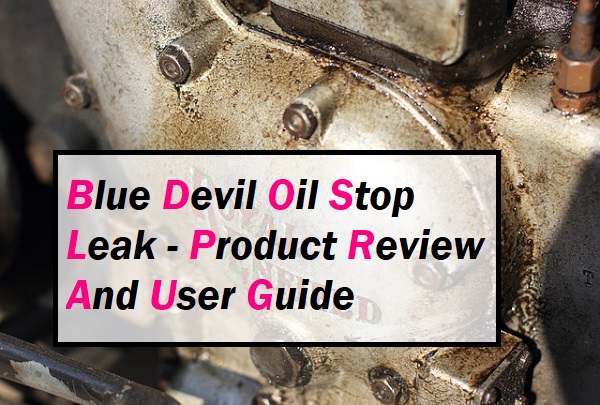Lug nuts aren’t the sexiest of topics. But for those new to the home garage movement it pays to know a bit about them.
So read on for…
When we were new to mechanics we had a lot of questions. Many of those are featured below, in our quest to answer the most frequently asked questions about lug nuts.
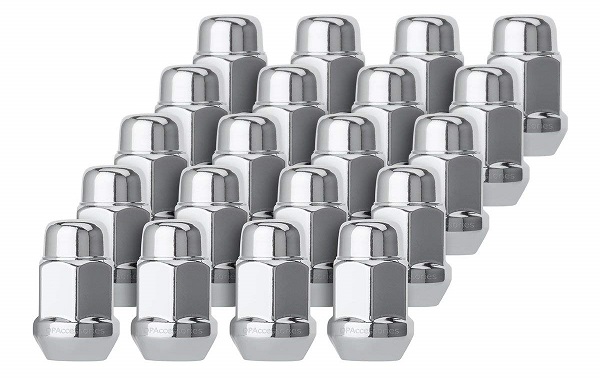 Lug nuts are the bolts used to hold your wheel to your axle on your vehicle, typically a car or truck.
Lug nuts are the bolts used to hold your wheel to your axle on your vehicle, typically a car or truck.
 When installing lug nuts it’s highly recommended that you give the nut or bolt at least 10 turns by hand before ever putting a wrench on it to ensure that no cross threading has occurred, and that the threads are free of obstructions.
When installing lug nuts it’s highly recommended that you give the nut or bolt at least 10 turns by hand before ever putting a wrench on it to ensure that no cross threading has occurred, and that the threads are free of obstructions.
Once you’ve done that tighten the nuts all the way down to snug by hand before ever putting a torque wrench to them.
This ensures not only that the threading is correct, but that the nuts have centered correctly in the lug holes of the wheel.
Lug nuts must be installed in an alternating pattern, commonly referred to as a “star-pattern” technique of applying torque to one lug nut, then the one directly across from it, but it’s important enough to bear repeating.
Torquing the lug nuts in this manner ensures that they center properly.
Torque one nut, then cross the center of the wheel for the next nut, and so on.
For a 5-bolt pattern, this will have you torque the nuts in the classic star pattern. For a 4-bolt, it’s a cross pattern.
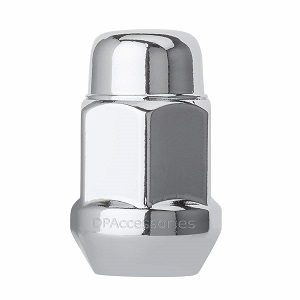 For the most part, dealing with lug nuts only involves using the ones that came with the wheels.
For the most part, dealing with lug nuts only involves using the ones that came with the wheels.
However, changing wheels will often require different lugs, and this is where it becomes important to determine that they are the correct type for the wheel.
Having the correct lug nut for your vehicle helps ensure that your wheel is safely and securely installed.
Conical
The most common type of lug nuts, conical lugs are cone shaped and designed to fit a corresponding cone-shaped lug hole. A taper of 60 degrees is still the most common style.
Conical lugs are generally easy to work with and center correctly just about every time.
Flat
Flat lug nuts have a mounting surface that simply extends out 90 degrees from the lug stud and looks like a large washer.
Most also have a small barrel that extends into the wheel’s lughole for centering, which is what makes them somewhat tricky to deal with.
Ball
Ball-style lug nuts are essentially round rather than cone-shaped. Thankfully, there are relatively few of these types left in service, as it can be very difficult to tell them apart from conical styles.
Confusing the two can cause serious – and usually irreparable – damage to the mating surfaces on the wheel.
Ball lug nuts can, however, still be found on certain Mercedes, Audi, VW and Honda vehicles.
Tuner
Many aftermarket wheels are designed for extremely small diameter lug nuts usually known as tuner lugs. In the olden days, tuner lugs were open in the center and designed to accept a solid hex-shaped key for installation and removal.
Most are not made this way anymore, as the open design allows a wide-open pathway for air and moisture to get to the studs and threads, causing serious corrosion problems.
In this case, it’s a good idea to recommend changing them out for a set of the newer spline drive lugs.
Spline Drive
These lugs have many narrow grooves on the head and even down the sides that will accept a special low-profile key that can just fit over the lugs and into the lugholes.
Some people tend to think that spline drive lugs are akin to wheel locks and will protect their wheels from theft which is not true.
The spline drive key is never a unique pattern, and are easily available from any auto parts store. Relying on spline drive lugs for theft protection is no protection at all.
Lug Bolts
While most cars have lug studs coming out from the rotor plate, some cars, particularly BMW, will have lug bolts that thread into the rotor plate.
They are typically seen on European vehicles. Most tire techs despise this as it means you can’t just hang the wheel assembly on the lug studs while you thread the nuts on.
Instead, you must hold the heavy assembly up against the rotor plate while threading the bolts through the wheel and into the rotor, a process that requires approximately 3½ hands.
 Lug nut sizes have a specific thread pitch, which is determined by vehicle specifications.
Lug nut sizes have a specific thread pitch, which is determined by vehicle specifications.
Having the correct lug nut for your vehicle helps ensure that your wheel is safely and securely installed.
Different lug nut sizes:
- 10mm X 1.25
- 12mm X 1.25
- 12mm X 1.50
- 12mm X 1.75
- 14mm X 1.25
- 14mm X 1.5
- 14mm X 2.0
- 7/16″ X 20
- 1/2″ X 20
- 9/16″ X 18
Each nut should be fairly tight but not too close to the final torque.
They must be tight enough so they won’t come loose and the heat will transfer uniformly from the hub to the wheel for cooling.
That heat transfer needs to be uniform so it is important that they all be torqued to the same value.
Typically this is somewhere around 90 ft-lbs.
The proper way to tighten the wheel is to use a torque wrench to torque every lug nut to its recommended torque when the car is on the floor.
Some cars even require more complex procedure which is hand tight first, torque to a specific lower torque while the car is up in the air, then torque to its final torque specification when the car is on the floor.
Here are the steps on how to tighten the wheel lug nut properly:
- Wipe every stud with a rag and air blow the inside of each lug nut to clean them.
- Use hand to tighten each lug nut onto the studs.
- If you have an impact wrench, you may use it to barely snug up each lug nut, stop as soon as possible when you hear a couple of clicks.
- Drop the car on the floor.
- Set the manufacturer recommended torque on the torque wrench and tighten each nut according to it.
The right order to tighten the lug nut is not clock or counterclockwise.
If it is a four stud wheel, you should tighten them in a cross order, which means first tighten the top one, second the bottom one, third the left one, last the right one and so forth.
If it has five studs, then you should follow an order of drawing a star.
It is recommended to re-torque the lugs after about 200 miles of driving, especially on alloy wheels.
Some technicians use an impact wrench to tighten every lug nut until he hear many clicks. However, not too many people notice that all the lug nut could be over tighten that way.
It’s remotely possible that dirt or corrosion is causing certain nuts to seem tight when they aren’t.
In that case it is recommended to clean any that seem like they might be a problem, and to apply some anti-seize compound.
Over tighten can stretch the stud and cause failure around the rotor.
It can also be the reason of brake warping on a vehicle.
It can make them virtually impossible to remove with normal tools (especially typical lousy tire irons) which can turn a flat tire into a need for a tow.
On some cars, it can cause warpage of brake discs or drums, or even of wheel hub flanges. And in extreme cases, it can cause the lug stud to break off.
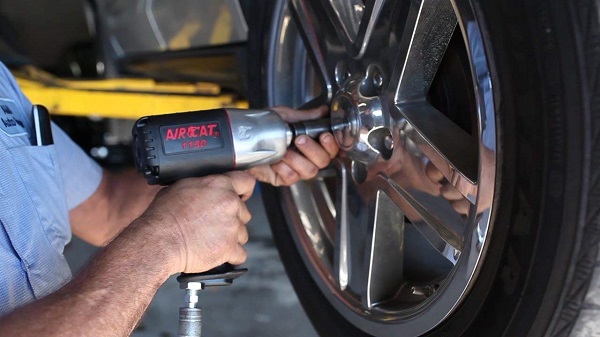 While a lug, socket or impact wrench may be used to tighten lug nuts the final tightening should be performed by a torque wrench, ensuring an accurate and adequate load is applied.
While a lug, socket or impact wrench may be used to tighten lug nuts the final tightening should be performed by a torque wrench, ensuring an accurate and adequate load is applied.
Using the manufacturer recommended torque helps guarantee that there isn’t either too much or too little pressure on any of the assemblies to which the wheel attaches.
Before you install your wheels, check your vehicle’s recommended torque.
The general rule for steel wheel lug nut torque is usually around 80-90ft/lb, and for aluminum wheel is around 100ft/lb.
It can be used in most cases, but we would still prefer you to research for the exact torque for every particular model before you start working.
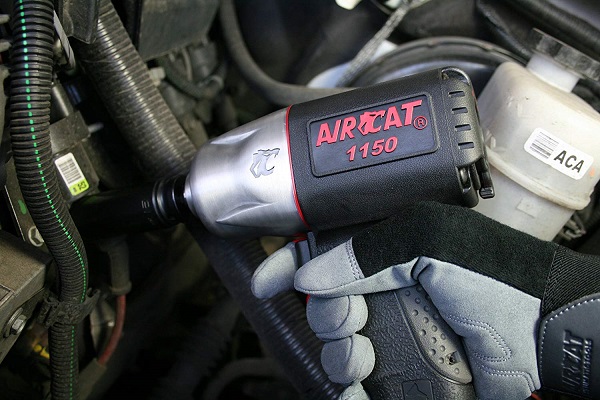 Lug nuts may be removed using a tire iron, lug or impact wrench.
Lug nuts may be removed using a tire iron, lug or impact wrench.
Tire irons can be purchased in your local auto parts stores that usually have an end that fits all vehicles.
You may also choose to simply use a deep socket of the appropriate size with a ratchet or breaker bar.
If the lug nuts have rusted over, apply a generous amount of a thread loosener or rust remover to the nuts.
Allow it to sit for a few minutes, then attempt to loosen the lug nut again.
If the lug nut and stud break, you will need to have a new lug stud installed in order to repair the vehicle.
Be sure to use the correct sized socket.
A socket that is slightly too large could round off the lug nut.
If the wheel is to be removed then an automotive jack to raise the vehicle and some wheel chocks would be used as well.
Wheels that have hubcaps or hub covers need these removed beforehand, typically with a screwdriver, flatbar, or prybar.
- Failure to abide by the recommended torque value can result in damage to the wheel and brake rotor/drum.
- Additionally, under tightened lug nuts may come loose with time.
- Lug nuts can be difficult to remove, as they may become frozen to the wheel stud.
- It is crucial that the lug nut seat and the wheel lug seat match.
- If the lug nut seat type does not match the wheel seat type, it is possible that the lug nut could damage the wheel.
- It is also likely that a mismatched lug nut and wheel could potentially cause the lug nut to loosen and the wheel to become unsecure to the vehicle.
- If the lug is not centered just right, the stem can catch on the flat mounting surface rather than going into the hole, and if you’re not paying attention it can seem as if the lug nut has tightened when in fact it has not.
- The best way to avoid this is to hand-tighten all the lug nuts to ensure proper fit before applying final torque.
- Swelling lug nuts are common to Chrysler, Ford, and Toyota vehicles. The chromed caps separate from the steel nuts, moisture gets in between the two and causes corrosion, and the nuts swell.
In such circumstances a breaker bar or repeated blows from an impact wrench can be used to free them.
- Alternating between tightening and loosening can free especially stubborn lug nuts.
- If the wheel is seized in place and won’t come off from you pulling on it, use a rubber mallet to bang it loose.
- Strike the tire where the rim and tire meet all along the circumference of the wheel until it breaks loose.
- Do not use a metal hammer to hit the rims or you may damage them.
- It may take a good deal of force to remove the wheel if it is rusted in place.
- For stubborn nuts, heat the nut with a torch, then move the flame away and immediately apply WD-40 or any other penetrating oil against the heated bolt threads.
- The quick change from high heat to to the cool oil will cause the nut to retract and expand, allowing the penetrating oil deeper into the threads to create a slippery surface.
- You can do this multiple times. Just make sure there is nothing flammable around when torching.
- After doing this a couple times, use a breaker bar to pull it free.
- If this fails, you may need to use an angle grinder to cut a groove in the nut, and a flathead bit on a hammer drill to get it out.
Self-Help
It is better to have a stripped or rounded lug nut cut off by a professional.
However, if you are ready to give it a try and remove rounded nuts yourself here is how:
- First of all take a socket, place its mouth on the lug nut, and tap with the back with the hammer.
- Make sure you don’t hit too hard. That may have the socket stuck badly.
- Keep tapping till it fits well.
- Secondly take the beaker bar and fit it onto the socket’s back.
- Start hitting with the hammer on the breaking bar’s handle to the left.
- When you do so a couple of times, you will feel that you are getting closer to breaking the lug nut free.
- With persistent pressure towards the right, the lug nut will break free with a jerk.
- Twist the socket clockwise and anti-clockwise a bit and pull it out. It will come off easily.
- Once the nut is off, you still have to deal with the lug nut which will still be stuck in the socket.
- Loosely screw the nut along with the socket back again.
- Then gently tap the socket up and down with the hammer.
- The socket will come out while the nut will be right there loosely screwed in.
- You can twist it with your hand and pull it out.
Well, hopefully that whirlwind tour of lug nuts and all they’re about has been helpful and you’re now better placed to work with them.
Let us know below, we’d love to hear from you.
What next?
Why not check out our recent post on how to remove a stripped lug nut (an altogether different kettle of fish!).
Or check out our new guide on the best air impact wrench for lug nuts to make things an absolute breeze.
Sources:



